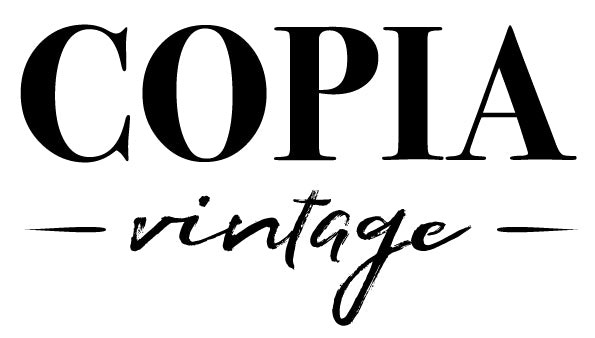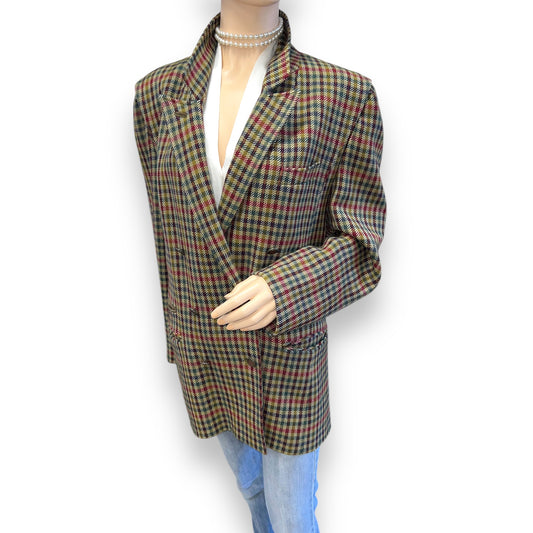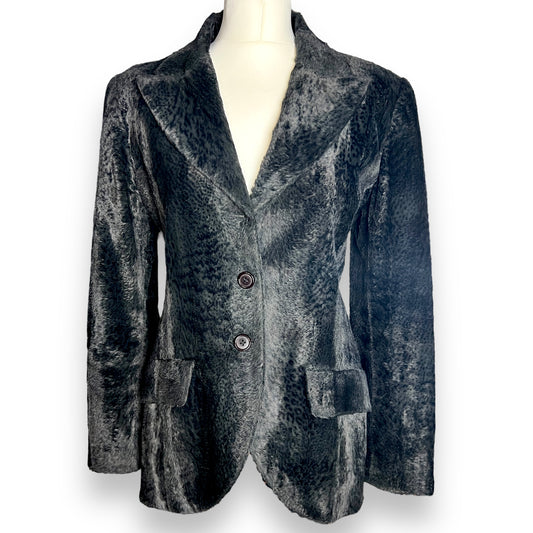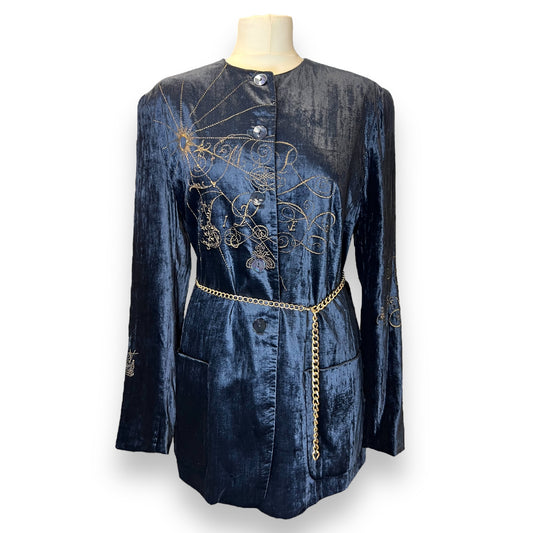Collection: 1980s
A return to glitz and glamour, striking or brash colours and bold prints. And black is back. The body makes a comeback, no longer hidden under voluminous 70’s shapes. Imaginative and artistic street style and designer clothes initially remain in two separate camps until the mid-80’s financial boom. Shoulder pads, power-dressing and high-waisted suits are synonymous with the decade. Pirates and dandies inspire the New Romantics. Hip-hop introduces sportswear as streetwear, with bling! Leggings, legwarmers, leotards/’bodies’. It’s a mishmash of dressing-up, of the avant-garde creations of Japanese designers, of futuristic minimalism and of shell-suits, dancewear, punk and Sloane Rangers!
Skirt shapes evolve: Vivienne Westwood’s mini-crini, Christian Lacroix’s puffball, tutus and the ubiquitous ra-ra. Jean Paul Gaultier’s quirky play on fashion conventions, coined ‘inner wear as outer wear’, are thrilling and comic, as are the eccentric designs of Jean-Charles de Castelbajac. Katherine Hamnett’s slogan T-shirts use fashion for political statement. BodyMap’s avant-garde designs come and go within the decade.
From the New York fashion mecca, Ralph Lauren, Calvin Klein and Donna Karan bring classic luxury, blazers and flannels. Labels are proudly displayed as status-symbol dressing. Diana, Princess of Wales, becomes a royal fashion icon. Chanel, Thierry Muglar, Giorgio Armani, Karl Largerfeld, John Galliano, Helmut Lang, Gianni Versace, Rifat Ozbek, Nicole Farhi and Agnes B are prominent designers in the decade. Moschino’s designs are well-tailored and witty and his Cheap & Chic line cheeky and creative. Up-market, boutique labels like Escada, Laurel, Joseph, Mondi and Ghost produce quality, contemporary clothing at marginally less eye-watering prices.
Body-conscious styling begins to creep back in as the oversized, masculine shapes lose their appeal. The Lycra revolution heralds stretchy, streamline looks favoured by Azzedine Alaia.
“There will be a backlash against overdressing and ostentation. Economic conditions will change things, clothes will have to work for life.” Geoffrey Beene.
-
Basler Tweed Double-Breasted Blazer 1980s
Regular price £90.00 GBPRegular priceUnit price / per -
Kenzo Dark Leopard Print Velvet Blazer 1980s
Regular price £125.00 GBPRegular priceUnit price / per -
Mondi Blue Velvet and Gold Embroidered Jacket 1980
Regular price £105.00 GBPRegular priceUnit price / per -
Jaeger Classic Tweed Blazer 1980s
Regular price £90.00 GBPRegular priceUnit price / per -
Valentino Embroidered Cuff Tweed Jacket 1980s
Regular price £195.00 GBPRegular priceUnit price / per -
Jean Muir Splattered Silk Wrap 1980s
Regular price £130.00 GBPRegular priceUnit price / per -
Escada Couture Glitter Cardi / Blazer 1980s
Regular price £165.00 GBPRegular priceUnit price / per -
Jean Muir Chocolate Leather Jacket 1980s
Regular price £145.00 GBPRegular priceUnit price / per -
Jaeger Coloured Tweed Cropped Jacket 1980s
Regular price £99.00 GBPRegular priceUnit price / per -
Valentino Boutique Pink Jacket 1980s
Regular price £140.00 GBPRegular priceUnit price / per -
 Sold out
Sold outChristian Dior Mustard Blouse 1980s
Regular price £119.00 GBPRegular priceUnit price / per -
Jean Muir A-symmetrical Suede Skirt 1980s
Regular price £150.00 GBPRegular priceUnit price / per -
Chanel Black/White Striped Shirt 1980s
Regular price £315.00 GBPRegular priceUnit price / per -
Bruce Oldfield Silk Cocktail Suit 1980s
Regular price £210.00 GBPRegular priceUnit price / per -
Valentino Boutique Cashmere Dress 1980s
Regular price £265.00 GBPRegular priceUnit price / per -
Valentino Boutique Velvet Trim Jacket 1980s
Regular price £150.00 GBPRegular priceUnit price / per
















